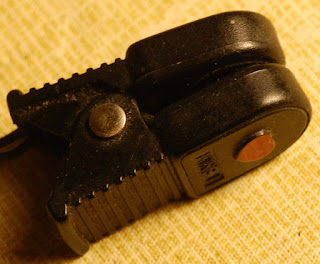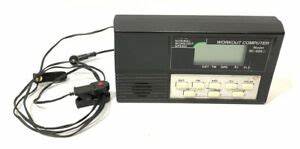Sometimes the old tricks fail . . .
. . . OR is that IR LED working ?
I remember being at work talking with a tech repairing an IC handler (used in automatically testing DIP packaged ICs) - this was in the 1980s. He was checking some optical sensors used to keep track of the IC chip progress through the handler. The sensors used an IR LED and a phototransistor pair to sense the IC passing by.
He pulled out what looked like a small Popsicle stick with faint yellow paint on the end. It was some kind of chemical that glowed when the IR light shined on it.
Fast forward to 2022, I am looking at a pulse sensor from an exercise computer which I *think* uses the same concept: an IR LED plus phototransistor. This pair is mounted on a clip that is put on your ear lobe while exercising. The amount of IR light from the LED reaching the phototransistor is modulated by a person's pulse. I'm not quite sure which of the two items is the LED and which is the transistor.
 |
| the pulse sensor |
 |
| a stock photo of the pulse sensor and exercise computer |
Anyway, I remember that cell phone cameras (at least cheap Android ones like the one I have) can see IR. One way to demo this is to take the phone and an IR remote into a dark room or closet and hit the remote buttons while pointing it at the cell phone camera with the camera app on. A photo like this should be obtained:
 |
| IR remote image by cell phone in dark room |
So I tried this with the pulse sensor but no-go. So either the IR LED is too dim or has a very narrow angle or possibly it's not even IR LED ?
After thinking about it I puzzled out the pinout of the sensor, tip was the photo diode/transistor, ring was the IR LED and the sleeve was ground. I tried measuring the IR LED current and it was extremely low, at most 20 uA. So that may be why the cell camera cannot see the IR LED.
It also may be why the exercise computer doesn't sense my pulse reliably.
Looking inside the exercise computer, there is a separate board for the pulse sensor with what appears to be a quad op-amp (14 pins). The part number has been scratched off with a rotary tool.
 | |
| why scratch off the part number ? we can guess it's a quad op amp |
It may be time to try rolling my own pulse sensor and readout, I never did like that ear lobe sensor anyway.
Best Regards,
Chuck, WB9KZY
http://wb9kzy.com/ham.htm